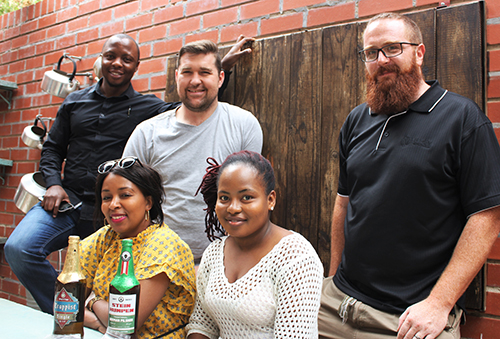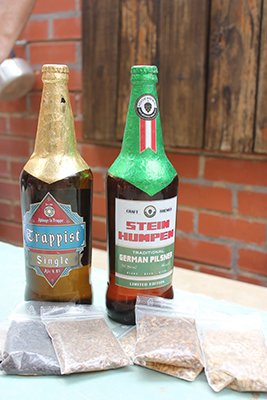
Visitors from SA Breweries (AB InBev), Khosi Mogotsi,
Patience Selesho and Zinhle Ngcobo with
Dr Jan-G Vermeulen and Dr Errol Cason from
Kovsie Brewery.
Photos: Moeketsi Mogotsi
With the recent procurement of SAB by Anheuser-Busch InBev SA/NV (AB InBev), a Belgian transnational beverage and brewing company, the 500L educational brewery located at the SAB Cyril Ramaphosa World of Learning, became available for donation. After an initial shortlisting of three universities, the SAB World of Learning Brewery was awarded to the University of the Free State (UFS) to be managed by Kovsie Brewing.
Prof Corli Witthuhn, Vice-Rector: Research at the UFS, approved the application for a micro-manufacturing liquor licence right in the middle of campus, which effectively put the UFS bid in a class of its own. It is part of her vision that entrepreneurial activities must be visible on campus”
Sixteen universities were approached to obtain the brewery for their respective campuses.
Kovsie Brewing is an initiative started by postgraduate students at the UFS Department of Microbial, Biochemical and Food Biotechnology in 2012. The main objective of this initiative was to expose BSc students to brewing as a practical application of the scientific fields presented at the department.

Label mock-ups made by
Dr Jan-G Vermeulen from
Kovsie Brewery entered into
the yearly SAB Intervarsity
Brewing Competition. Kovsie
Brewing has won the best label
competition in 2013, 2014 and 2015
and was placed in the top three in
2016 and 2017.
First brewing and fermentation school
Dr Errol Cason, project leader at Kovsie Brewery, said: “Over the past five years the small-scale experimental brewery has steadily grown to the point where we obtained institutional support to establish the first Brewing and Fermentation School at the university.
Dr Cason explains that the primary role of Kovsie Brewing is to establish an accredited fermentation-based curriculum at the UFS to educate undergraduate and postgraduate students in the scientific process involved in the production of beer. “In addition, the donation enables Kovsie Brewing to provide practical job-related training and skills development on industrial grade equipment,” he said.
Emphasis on entrepreneurship
The secondary role is for Kovsie Brewing to function as a multi-disciplinary platform to stimulate the interaction between students from various fields of study. Currently Kovsie Brewing has well-established cooperative projects with both Marketing and Entrepreneurship programmes.
“In the future, Kovsie Brewing will expand on these multi-disciplinary interactions by incorporating other departments of the UFS with the focus on product development, logistics, as well as the legal aspects concerned with brewing,” Dr Jan-G Vermeulen from the Kovsie Brewery team said.
Corporate social investment representatives from AB InBev recently visited the university. Among others they met Drs Vermeulen and Cason. During their visit they also looked at other university projects, including the Department of Paediatric and Child Health and the Universitas Hospital, the Engineering Sciences Department and the Naval Hill Planetarium.
Khosi Mogotsi from AB InBev said: “It was wonderful to experience the passion with which UFS staff do their work.”